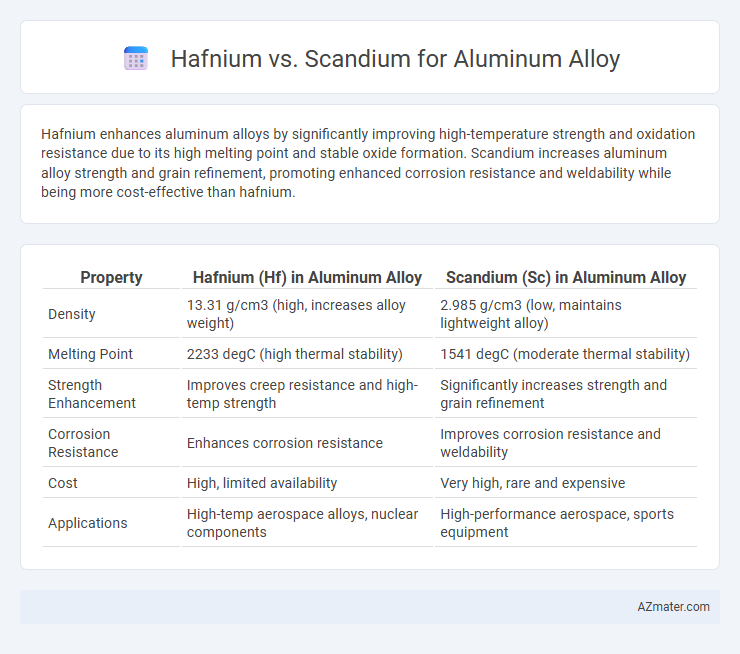Hafnium enhances aluminum alloys by significantly improving high-temperature strength and oxidation resistance due to its high melting point and stable oxide formation. Scandium increases aluminum alloy strength and grain refinement, promoting enhanced corrosion resistance and weldability while being more cost-effective than hafnium.
Table of Comparison
| Property | Hafnium (Hf) in Aluminum Alloy | Scandium (Sc) in Aluminum Alloy |
|---|---|---|
| Density | 13.31 g/cm3 (high, increases alloy weight) | 2.985 g/cm3 (low, maintains lightweight alloy) |
| Melting Point | 2233 degC (high thermal stability) | 1541 degC (moderate thermal stability) |
| Strength Enhancement | Improves creep resistance and high-temp strength | Significantly increases strength and grain refinement |
| Corrosion Resistance | Enhances corrosion resistance | Improves corrosion resistance and weldability |
| Cost | High, limited availability | Very high, rare and expensive |
| Applications | High-temp aerospace alloys, nuclear components | High-performance aerospace, sports equipment |
Introduction to Aluminum Alloying Elements
Hafnium and scandium are critical alloying elements used to enhance aluminum alloys' mechanical properties, corrosion resistance, and weldability. Hafnium improves grain refinement and high-temperature stability, making it ideal for aerospace and automotive applications where thermal resistance is required. Scandium significantly increases strength and reduces grain size, resulting in lightweight, high-strength aluminum alloys favored for sports equipment and aerospace components.
Overview of Hafnium in Aluminum Alloys
Hafnium in aluminum alloys significantly enhances high-temperature strength and corrosion resistance, making it ideal for aerospace and marine applications. Its ability to form stable intermetallic compounds improves grain refinement and mechanical properties under extreme conditions. Unlike scandium, hafnium provides superior creep resistance, contributing to longer component lifespan in demanding environments.
Scandium as an Alloying Agent in Aluminum
Scandium significantly enhances aluminum alloys by refining grain structure, improving weldability, and increasing strength and corrosion resistance compared to hafnium. Its ability to form fine Al3Sc dispersoids inhibits recrystallization, resulting in lightweight yet highly durable materials ideal for aerospace and sports equipment. While hafnium provides some enhancement, scandium's superior grain refinement and thermal stability make it a preferred alloying agent for premium aluminum alloys.
Comparison of Mechanical Properties
Hafnium enhances aluminum alloys by significantly improving high-temperature strength and creep resistance, making it ideal for aerospace applications requiring thermal stability. Scandium, on the other hand, refines grain structure and boosts toughness and corrosion resistance, providing superior fatigue strength and weldability. Comparing mechanical properties, hafnium-alloyed aluminum exhibits higher tensile strength at elevated temperatures, whereas scandium-alloyed aluminum offers enhanced ductility and fracture toughness.
Effects on Corrosion Resistance
Hafnium significantly enhances the corrosion resistance of aluminum alloys by forming a stable oxide layer, which prevents further oxidation and improves durability in harsh environments. Scandium also improves corrosion resistance but primarily strengthens the grain structure, indirectly reducing corrosion susceptibility by minimizing grain boundary attack. Hafnium's oxide formation offers superior protection compared to scandium, making it more effective in applications requiring robust corrosion resistance.
Impact on Weldability and Fabrication
Hafnium enhances aluminum alloy weldability by improving grain refinement and reducing hot cracking susceptibility during fabrication, leading to stronger, defect-free joints. Scandium contributes to refined microstructures and increased strength but tends to form coarser precipitates that may complicate weldability under certain conditions. Optimal aluminum alloy fabrication balances hafnium's weldability benefits with scandium's strength gains to achieve improved mechanical performance and fabrication efficiency.
Cost and Availability Considerations
Hafnium is significantly more expensive and less abundant than scandium, which impacts its feasibility for widespread aluminum alloy production. Scandium's relative availability and lower cost make it a preferred choice for enhancing aluminum alloys, especially in the aerospace and automotive industries. Cost efficiency and supply stability drive the preference for scandium despite hafnium's potential performance benefits in some high-temperature applications.
Industrial Applications and Performance
Hafnium and scandium significantly enhance aluminum alloys used in aerospace and automotive industries by improving strength and corrosion resistance. Hafnium offers superior high-temperature stability, making it ideal for jet engine components and nuclear reactors, while scandium excels in grain refinement and weldability, crucial for lightweight structural parts and sports equipment. Both elements contribute to increased durability and performance, with scandium favored for cost-sensitive applications and hafnium preferred in extreme-environment conditions.
Environmental and Sustainability Factors
Hafnium enhances aluminum alloys by improving high-temperature strength but is less abundant and more energy-intensive to extract compared to scandium, which is rarer yet offers superior grain refinement and corrosion resistance with lower environmental impact. Scandium's limited reserves and high extraction costs challenge large-scale sustainability, while hafnium's byproduct status in zirconium mining slightly mitigates its environmental footprint. Sustainable aluminum alloy production favors scandium for its recyclability and reduced ecological disturbance, despite both elements contributing to more durable, lightweight alloys that enable energy savings in transportation.
Future Trends in Aluminum Alloy Development
Hafnium and scandium play critical roles in advancing aluminum alloy properties, with scandium widely recognized for refining grain structure and enhancing strength and corrosion resistance in aerospace and automotive industries. Emerging research on hafnium-doped aluminum alloys indicates promising improvements in high-temperature stability and creep resistance, positioning hafnium as a potential game-changer for next-generation aluminum alloys in extreme environments. Future trends in aluminum alloy development prioritize synergistic alloying strategies combining scandium's grain refinement with hafnium's thermal stability to produce ultra-high-performance lightweight materials.

Infographic: Hafnium vs Scandium for Aluminum Alloy
 azmater.com
azmater.com